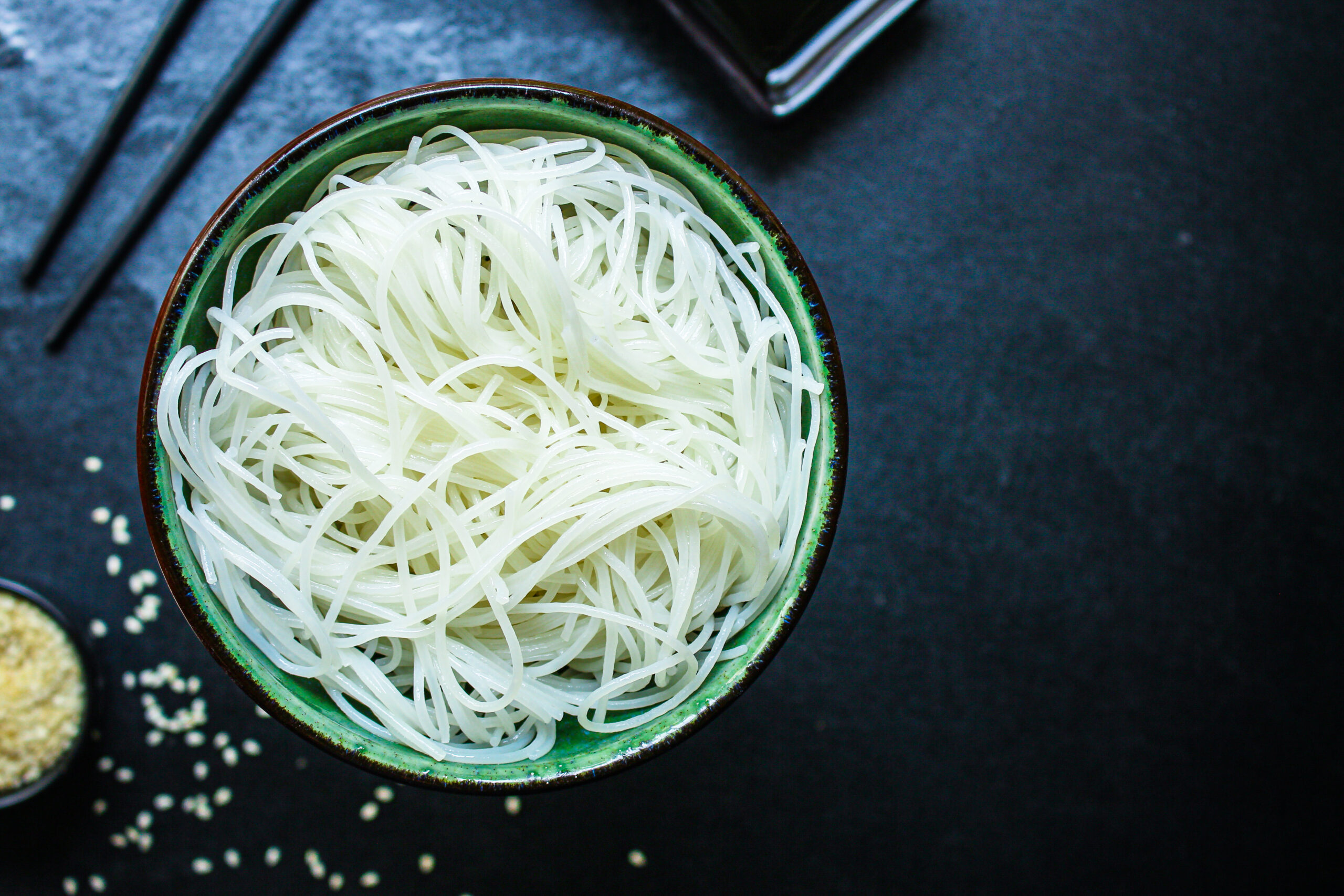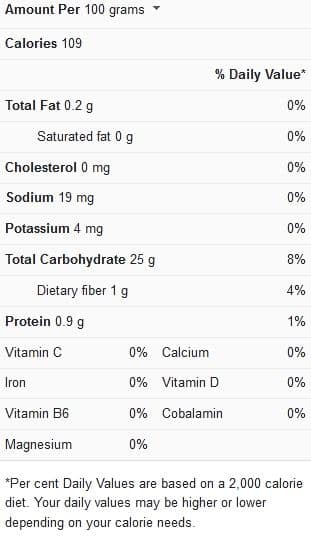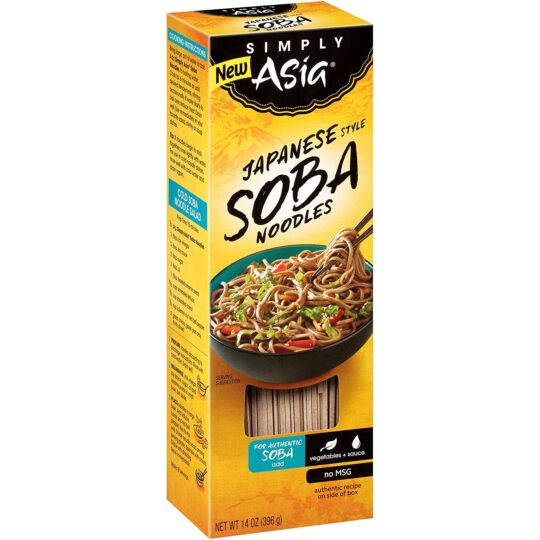Updated on April 9th, 2023
You might have grown up thinking of pasta as being just spaghetti and macaroni, but that’s not the case. Various noodles fall under the umbrella of “pasta” today; we closely look at rice noodles.
Rice noodles are available in various shapes and sizes, ranging from hair-thin vermicelli to the large smooth rice sheets used in Chinese dim sum. These noodles, like rice, have little flavor on their own, but they work nicely in stir-fries or dipped in curries with mild broths or spicy sauces.
However, you may need to learn about some excellent rice noodles substitutes for your benefit. Read on as you learn about rice noodles, uses, and applications.

Rice Noodle Nutrition Facts

What Is Rice Noodle
Rice noodles are essentially made from two primary ingredients: rice flour and water, combined in a method that has stood the test of time since they were originally made in China over 2000 years ago.
To improve the transparency or increase the gelatinous and chewy texture of the noodles, substances like tapioca or corn starch are sometimes added. Rice noodles are most commonly seen in East, Southeast, and South Asian cuisines.
Rice stick noodles are comparable to bean threads but have a higher carbohydrate content. Rice sticks are incredibly convenient because they don’t need to be cooked and can just be soaked in warm water.
They come in various forms, thicknesses, and textures and are available fresh, frozen, or dried. Fresh noodles are also perishable, with a shelf life of only a few days. You can purchase in Asian grocery stores and select supermarkets with a well-stocked Asian ingredient section.
Rice Noodle Uses in Recipes
Rice noodle is an awesome t dish that may appeal to folks who want to reduce their calorie or carb intake.
Notably, rice noodles can be a filling alternative to other noodles for individuals attempting to lose weight, with only 20 calories per cup and no carbs. It also has the advantage of not falling apart as easily when stir-fried.
See some delectable recipes you can efficiently use rice noodles in:
- Chicken Stir Fry with Rice Noodles
- Vegan Singapore Noodles
- One-Skillet Singapore Rice Noodles
- Garlicky Pad See Ew (Thai Rice Noodle Stir)
- Fried Rice Vermicelli
- Beef Stir Fry with Flat Rice Noodles
- Rice Noodles Stir Fry
- Stir-Fried Chow Fun Flat Rice Noodles
- Singapore Chow Mein Fun
- Pad Woon Sen
- Chicken Pad Thai
- Vietnamese Stir Fry Rice Noodles with Beef
- Thai-Inspired Chicken & Rice Noodle Soup
- Thai Noodle Salad with Peanut Sauce
- Quick Chinese-Style Vermicelli
Rice Noodle Substitutes
You have learned quite a lot about rice noodles. These noodles, like rice, are bland on their own, but they’re delicious in stir-fries or dipped in curries with mild broths or spicy sauces.
You might not have any rice noodles on some days, or maybe you will rather opt for something different. Check these remarkable rice noodle substitutes out:
Soba Noodles
Soba noodles are a tasty substitute for rice noodles in your recipe. Soba noodles, traditionally produced from buckwheat, have a nutty flavor and a chewy texture that makes them ideal for soups and stir-fries.
Soba noodles are also gluten-free, making them a great choice for gluten sensitivities, Celiac disease, or eating a vegan diet.
Soba is a type of Japanese buckwheat flour noodle that has been around since the Middle Ages. Zen Buddhist monks eat buckwheat flour and water combined into a ball before going into profound meditations and extended fasts, which is a potent, high-vibration diet.
The nicest part about these delectable Japanese-style noodles is how quickly they prepare. You can put some vegetables in the saucepan, and dinner will be ready in 20 minutes.
Kaset Bean Thread Glass Noodles
Cellophane noodle, also known as bean strand, is another excellent rice noodle substitute for your consideration.
Cellophane noodle is used to make chewy, transparent, threadlike noodles. When softened in boiling water and cooked, bean threads become slick. Their muted flavor allows them to soak up all the other delicious flavors in the pan.
Notably, this noodle is great in soups with a lot of broth. In most recipes, you can substitute cellophane noodles for rice noodles (rice vermicelli).
Cellophane noodle is also known as glass vermicelli or glass noodles. It comes in various shapes, such as spaghetti-like strands, circular pieces, and rice-sized beads. Notably, mung bean starch is used to make cellophane noodles.
They are gluten-free, making them a good choice for dietary requirements. The noodle has a chewy texture but is not sticky like some other Asian kinds of pasta.
Udon Noodle
Udon noodles are a type of Japanese noodle that has been around for centuries. They have a more substantial feel and chew than regular rice noodles.
Udon noodle soups and stir-fries can be served cold or hot. You can try udon noodles instead of rice noodles if you seek a different noodle type.
Although these Japanese noodles resemble soba and can be substituted in some recipes, udon noodles are lighter in color, thicker, longer, and highly chewy, and can withstand heavier sauces and meaty broths.
Fresh, dried, or frozen, these dense noodles can be found in the freezer department of a local Asian grocery. It goes well with Peanut Chicken Noodle Soup and Kare Udon. As a result of its unique size, shape, and texture, the thick noodles are ideal for clinging to delicious sauces.
Frequently Asked Questions (FAQs)
In pad thai, what can I use instead of rice noodles?
You can use fettuccine or linguine instead of rice noodles if you can’t locate them at your store – or you are too lazy to go shopping but need dinner straight away. Both are flat, like regular rice noodles, and you’ll barely notice the difference if you’re starving.
What is another name for rice noodles?
Rice vermicelli is a thin noodle made from rice flour. It’s also known as ‘rice noodles’ or ‘rice sticks,’ but it’s not to be confused with cellophane noodles, which are a separate Asian type of vermicelli made from mung bean or rice starch rather than rice grains.
Are rice noodles and cellophane noodles the same noodles?
Both are Chinese-style noodles, but they are different materials. Rice noodles are created from rice flour and water, whereas cellophane noodles are made from mung bean flour and water and are known by numerous names such as transparent noodles, glass noodles, and bean thread noodles.
Conclusion
Rice noodles come in three sizes (small, medium, and large) used in soups, stir-fries, and traditional Pad Thai – you might even see them labeled as “Pad Thai noodles” at your local store. You may find them fresh in the refrigerated department or dry in the aisles.
Notably, these substitutions will work if you can’t get rice sticks. Still, the flavor will be slightly different, so I recommend using them exclusively in dishes with intensely seasoned sauces and garnishes.




